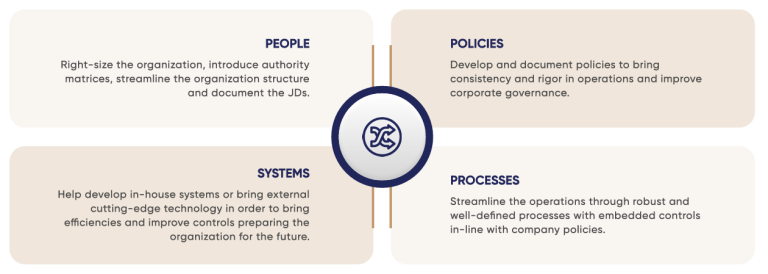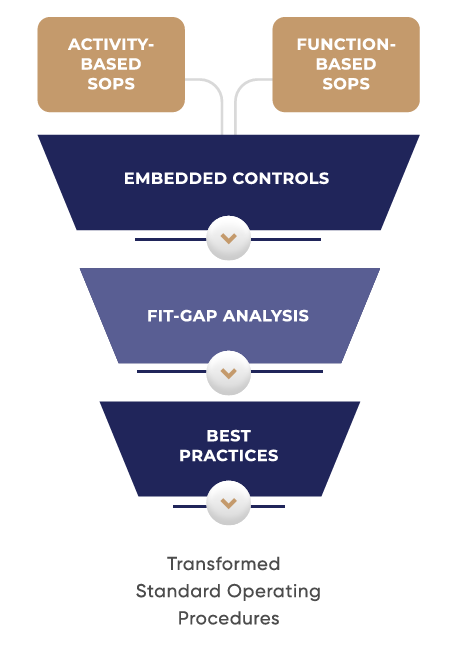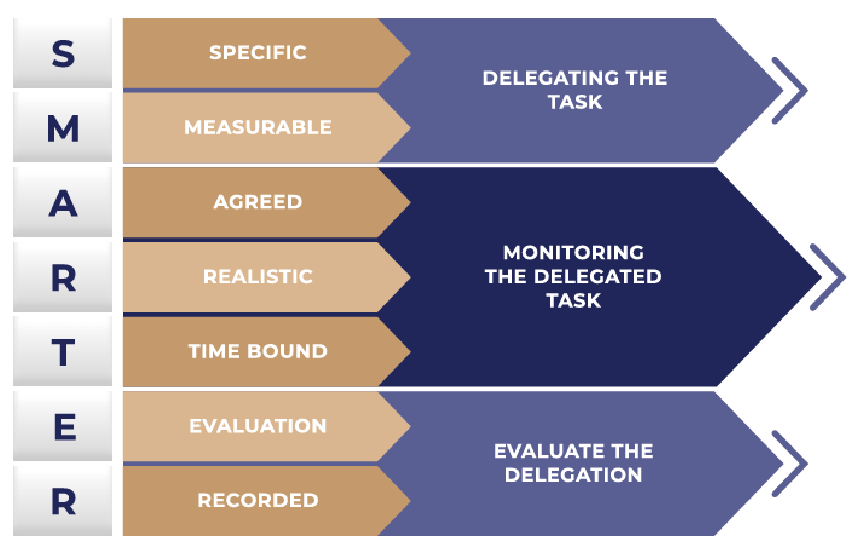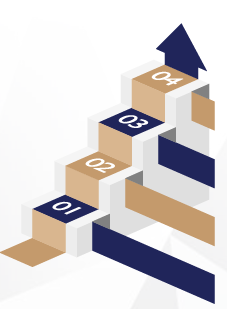Organizational Restructuring
Creating effective and tax efficient organization structures: entities, functions and departments, jurisdictions/various geographic location
+971 44054162
consult@hoft-global.co
UAE :-
Office 104, Building 4, Emaar Square, Downtown, Dubai, U.A.E
KSA :-
3175 King Salman Ibn Abdulaziz 83006 Al Yasmeen
Dist. Riyadh, KSA Postal Code: 13325
Pakistan:-
B-228, Sherbaz Business Center, B-Block Block B,
Satellite Town, Rawalpindi, Punjab 46300
UK :-
T17 Howitt Building Lenton Boulevard Nottingham
NG7 2BL England, United Kingdom




We define Business Transformation as a systematic strategic change driven by the top leadership involving people, policies, processes and systems. It has a wide array of objectives including improving productivity, growing business and increasing market share, improving customer satisfaction, improving quality of company’s products and services, being nimble, staying up to date with the market and competition, improving work culture, gaining technological advantage, enhancing leadership skills and improving company’s topline and/or bottom-line.

Our team approaches the strategic change in a holistic manner, covering all 5 aspects mentioned below. Given the nature of the proposed assignment, this document will only present Business Process Re-engineering in detail:
Creating effective and tax efficient organization structures: entities, functions and departments, jurisdictions/various geographic location
Helping management shareholders with leadership, vision, strategy, objectives, long term and short-term goals/targets, business plans.
Rationalizing business operations by re-designing SoPs, SLAs, DOAs, KPIs, Right sizing, JDs, Dashboards, Periodic & Ad-hoc Reporting
Realizing growth opportunities through technological enhancements,, flexibility, capability, integration, e-commerce and cloud integration.
Improving corporate governance and work ethics involving values, diversity, sustainability, competency development.
PI has a distinguished perspective of analyzing and improving an organization comprising of three stages explained below:
This stage involves developing a thorough understanding of the business including its operations, management, organizational structure, objectives, goals, future plans, applicable rules and regulations, niche, competitive environment, technology, etc. We go through every detail which helps us identify issues, risks, gaps and redundancies.
This stage involves using our understanding developed during Diagnostics stage & applying our in-depth industry understanding, our risk management and internal audit expertise & our business network to design a roadmap for the organization. Our methodology is to structure keeping in mind the severity and implement-ability of the issues ranked as per their cost-benefit analysis and effort-vs-disrupt ability index.
We implement the approved transformed processes in phases and stages ensuring smooth transitioning. By conducting pilot projects in isolation, we assess the accessibility and adaptability of the relevant stakeholders and amend the processes (quick fixed), if required.
We, at PI, strongly believe in designing tailor-made solutions for each organization in accordance with its own goals,
objectives, operations and future plans.
We analyze end-to-end activities such as Order to Cash, Procure to Pay, Hire to Retire covering all respective functions and sub-functions involved. This provides a clear understanding of how the information and documents flow through the organization highlighting redundancies and inefficiencies as well as any control weaknesses.
Each department/function in the organization such as Finance, HR and Sales are covered and mapped in isolation to identify the gaps as per the best practices and areas which can be made robust.
Through our time-tested methodology, our experts are able to cover end-to-end functions/departments as well as activity-cycles in their entirety identifying inefficiencies and potential redundancies that may remain hidden otherwise. Our approach for implementing the streamlined policies and procedures can be summarized as follows:
Having deep understanding of the existing processes & procedures helps us identify the control weaknesses, redundancies and cost saving opportunities.
Our experts are well-placed to recommend resolutions and improvements as per the best practices.
Once approved, we integrate improvements in the SOPs written in simple languages that is easy to comprehend with little guidance.
Our Business Process Re-engineering involves following elements:
Our SOPs are detailed yet easy to understand containing the following elements:
Our flowcharts are smartly designed to show each process in a logical sequence, plotted in a matrix of department / functions versus activities. This allows for readers, for each process, to quickly understand
a) chain of actions in a sequential order, b) all departments / functions involved and their required actions and c) list of activities to be performed for the process to be completed from the start to the finish.
Our descriptive processes (narratives) are written in simple, clear and concise language carrying sufficient detail for any person, especially new joiners, to comprehend with little guidance. The narratives are linked to the flowcharts both of which can be cross-referred for a clear and thorough understanding of the entire process.
Our SOPs are embedded with organization-specific and function-specific controls incorporating best practices to ensure efficiency and effectiveness. While preparing the SOPs, we conduct independent Fit-Gap Analysis in order to identify weaknesses, redundancies and inefficiencies and also recommend pragmatic solutions to enhance organization’s overall control environment and improve results.
Our SOP documents are supported with relevant forms and system screenshots which are duly referred to in the descriptive content for easy reference. In order to keep the SOPs easy to understand/comprehend, we compliment the SOPs with relevant glossaries and annexures.

Delegation is a process of assigning the responsibility for a specific task to individuals/teams within the organization and empowering them to accomplish the task effectively. Within the limits and established policies regarding various aspects of operations, approval levels are delegated as outlined in DOA matrix of the organization.
We use a specific type of Responsibility Assignment Matrix (RAM) called RACI which stands for:
The person who is assigned to do the job / task.
The last person in the reviewers chain who is ultimately responsible for its success / failure.
Experts/knowledgeable individuals who can provide valuable input. For example team members.
Those people who need to be kept in the loop on the progress. For example the CEO.
While preparing the DOA Matrix, we adhere to following rules.
Our DOA Matrices are effective means of structuring the responsibilities in a modern organization. It helps in comprehending the organization structure, clarifies roles and responsibilities, assesses & balances workloads and smoothens operations. In addition to this, our DOA Matrices also helps in keeping operations effective by assigning level of priority to tasks and resources, managing the staffing levels, and ensuring smooth transitions and handoffs in case of employee turnover.
Our DOA Matrix helps our clients organize tasks in the following manner:

Delegating The Task :
Identify and evaluate the task to be delegated Measure the resources required for the task Determine if tasks are appropriately delegated.
Monitoring the Delegated Task :
Regularly monitor the delegated tasks timely Allow channel for feedback Ensure deadlines are met as prescribed.
Evaluate the Delegation :
Performance is evaluated at individual level Completion of tasks is ensured and recorded
Service Level Agreements are commitments / agreements signed between two or more parties in relation to performance of an underlying service as per certain pre-agreed criteria. The objective is to ensure that all parties to the agreement are clear on the requirements from the outset and agree to them in advance to avoid any surprises later. In general, SLAs can be broadly categorized into the following two types:
These are generally intradepartmental, cross-functional or inter entities agreements. For example, an agreement between Procurement department and Production department whereby requirements for order levels, lead times, buffer stocks, type and quality of material, specifications, etc. will be pre-agreed between the two departments to ensure that products are prepared in accordance with customer requirements.
These agreements are signed between the company and its suppliers / service providers and / or customers. For example, an agreement between the IT department and the equipment maintenance company to ensure IT assets are kept up and running at all times.
Our SLAs, internal as well as external, are dynamic and support the inter/intra communication between/within organizations. Following are the salient features of our SLAs:
i. Comprehensive
All aspects are thoroughly covered: who, what, how, when?
ii. Performance Metrics
Various performance metrics are developed to ensure monitoring of the service provider’s (internal/external) performance. These are also embedded in the SLAs to ensure service providers agree and are held accountable for those in the future
iii. Protective
All necessary conditions and clauses are added to our SLA templates to ensure the client is protected in case of issues with performance levels. These include escalation clauses, emergency contact details, modes of escalation, remedial actions by the service providers, penalties / fines in case required and how to enforce them, termination clauses, etc.
iv. Clarity
SLAs are written in sufficient details to ensure that responsibilities of each party along with expectation levels are clearly identified to avoid any future disputes.
v. Flexible
Our SLAs are written in a manner that take into account various types of possible scenarios and how to address them including modifications, exceptions, limitations, tolerable limits / ranges.
We help our clients develop effective KPIs that focus on strategic and operational improvement by creating an analytical basis for decision making. Our KPIs are financial and non-financial covering strategic measures (customers, financial, internal processes, organizational capacity), operational measures, project measures, risk measures and employee measures. The wide coverage of our dynamic KPIs include inputs, processes, outputs, outcomes and projects. With our KPIs, the clients can target their focus on what matters the most. Our approach to developing effective KPIs is as follows:

Improve the KPIs: Constitute a mechanism of continuously monitoring the effectiveness of the KPIs and improve if necessary.
Report the KPIs: The KPIs are only useful when presented appropriately along with other relevant indicators in dashboard.
Develop the KPIs: The metrices should be able to clearly communicate the message by depending upon minimum number of indicators.
Collect the Data: The actionable data points must be pulled in order to construct an opinion on the progress of the process/team.
Establish Objectives: In order to be interpreted correctly, the KPIs should be linked to the organization’s goals and objectives – short, medium, long term.
Right-sizing is the logical conclusion to PI’s model of Business Process Re engineering through which we help our clients by critically analyzing the existing human resources in the light of updated policies and procedures and authority matrices.
We conduct specialized structural diagnostics across the organization in order to understand what each role is designed to do and how it is helping the organization in reaching strategic objectives. In addition to this, we also assess whether the employee in that role has the skills, expertise and knowledge required by using competency interviews and performance ratings. As a result, we right-size the organization by :
Eliminating any duplication of work and roles.
Designing the job descriptions and specification as per the industry norms.
Structuring the teams and roles as per the best practices.
Prescribing the appropriate expertise and competencies for required roles.
Preparing the HR policies and procedures related to recruitment, retention, grievance handling, termination, remuneration, performance evaluation, incentives, disciplinary actions, confidentiality breaches, etc.
Developing an appropriate mechanism for performance evaluation and appraisals.
Our approach towards re-engineering the business processes is comprehensive, result-driven and performance enabler in nature. We target identifying the weaknesses, resolving the bottlenecks and transforming the organization. It is contrary to the conventional approach of most competitors who only focus upon documenting the existing policies and procedures.
The following chart presents a comparison of PI’s approach and the conventional approach towards Business Process Re-engineering:
Our comprehensive approach involves conducting a detailed Diagnostics of the organization identifying weaknesses/issues, associated risks and bottlenecks. Followed by presenting a Structured Roadmap for improving the policies, processes, people and systems. While preparing the Structured Roadmap, we keep in mind the severity and implement-ability of the addressed issues ranked as per their cost-benefit analysis and effort-vs-disrupt-ability index. Once approved, our experts follow the Structured Roadmap to prepare the SOPs, DOAs, SLAs, JDs and right size the organization following three stages of documenting the As-Is, conducting the Fit-Gap Analysis and preparing the To-Be. This approach results in enhanced and efficient operations.
Processes are mapped end-to-end allowing better visibility of the business and the underlying processes & procedures across all functions.
All process maps are benchmarked against the best practices and significantly improved by resolving the bottlenecks and improving the processes.
Activity-cycles are covered in detail and improved by eliminating redundant processes resulting in highly productive business activities.
Authority Matrices define authority lines clearly identifying the roles & responsibilities of all participants ensuring effective decision making.
Effective communication between functions and teams is ensured through SLAs defining a framework for communication.
Right-sizing results in lean organization creating more values for customers with fewer resources.
Improved processes, authority lines, communication and team structures result in significant cost savings.
Our approach towards re-engineering the business processes is comprehensive, result-driven and performance enabler in nature. We target identifying the weaknesses, resolving the bottlenecks and transforming the organization. It is contrary to the conventional approach of most competitors who only focus upon documenting the existing policies and procedures.
The following chart presents a comparison of PI’s approach and the conventional approach towards Business Process Re-engineering:
Approach Summary
Advantages & Disadvantages
Better Visibility: Processes are mapped end-to-end allowing better visibility of the business and the underlying processes & procedures.
Improved Processes: All process maps are benchmarked against the best practices and significantly improved with clients’ consent.
Robust Productivity: Activity-cycles are covered in detail and improved by eliminating ineffective procedures.
Effective Communication: Effective communication between functions and teams is ensured through SLAs.
Defined Authorities: Authority Matrices define authority lines clearly identifying the roles & responsibilities of all participants.
Lean Organization: Right-sizing results in lean organization creating more values for customers with fewer resources.
Cost Savings: Improved processes, authority lines, communication and team structures result in significant cost savings.
Approach Summary
Advantages & Disadvantages
Incomplete Coverage: Due to a textbook approach, complex processes/procedures remain\undetected/ undocumented.
Zero Improvement: Processes are only documented as they are, without removing the bottlenecks and inefficiencies.
Unaffected Productivity: Activity cycles remain undocumented and unimproved resulting in no effect on the organizational productivity.
Ineffective Communication: Communication between functions and teams is neither documented nor equipped with a framework.
Blurred Authorities: Authority lines remain vague resulting in ineffective and inefficient decision making and delay in operations.
Dysfunctional Organization: The organizational chart remains untouched resulting in undetected weaknesses.
Costly Exercise: It remains a costly exercise with no significant outcome resulting in a negative impact in terms of cost benefit.
Feel free to contact us and one of our expert advisor will get in touch with you shortly.

To empower our partners to unleash their potential on their journey towards excellence, innovation & sustainable growth.



Copyright © 2024 HOFT Consulting | All Right Reserved